Discussion on the Geochemical Characteristics and Enrichment Process of Li-Rich Layers in Xian’an Coalfield, Guangxi Province, China
Abstract
1. Introduction
2. Geological Setting and Sampling
3. Analytical Methods
4. Results
4.1. X-Ray Diffraction Analysis
4.2. Geochemistry
4.2.1. Major Elements
4.2.2. Trace Elements
5. Discussion
5.1. Material Sources
5.2. Lithium Enrichment Process
6. Conclusions
Author Contributions
Funding
Data Availability Statement
Acknowledgments
Conflicts of Interest
References
- Dai, S.; Finkelman, R.B. Coal as a promising source of critical elements: Progress and future prospects. Int. J. Coal Geol. 2018, 186, 155–164. [Google Scholar] [CrossRef]
- Seredin, V.; Tomson, I. The West Primorye noble-rare metal zone: A new Cenozoic metallogenic taxon in the Russian Far East. Dokl. Earth Sci. 2008, 421, 745. [Google Scholar] [CrossRef]
- Dai, S.; Liu, C.; Zhao, L.; Liu, J.; Wang, X.; Ren, D. Strategic metal resources in coal-bearing strata: Significance and challenges. J. China Coal Soc. 2022, 47, 1743–1749. [Google Scholar]
- Dai, S.; Jiang, Y.; Ward, C.R.; Gu, L.; Seredin, V.V.; Liu, H.; Zou, D.; Wang, X.; Sun, Y.; Zou, J.; et al. Mineralogical and geochemical compositions of the coal in the Guanbanwusu Mine, Inner Mongolia, China: Further evidence for the existence of an Al (Ga and REE) ore deposit in the Jungar Coalfield. Int. J. Coal Geol. 2012, 98, 10–40. [Google Scholar] [CrossRef]
- Li, B.; Zhuang, X.; Li, J.; Querol, X.; Font, O.; Moreno, N. Geological controls on mineralogy and geochemistry of the Late Permian coals in the Liulong Mine of the Liuzhi Coalfield, Guizhou Province, Southwest China. Int. J. Coal Geol. 2016, 154, 1–15. [Google Scholar] [CrossRef]
- Seredin, V.V.; Dai, S.; Sun, Y.; Chekryzhov, I.Y. Coal deposits as promising sources of rare metals for alternative power and energy-efficient technologies. Appl. Geochem. 2013, 31, 1–11. [Google Scholar] [CrossRef]
- Sun, Y.; Zhao, C.; Li, Y.; Wang, J.; Zhang, J.; Jin, Z.; Lin, M.; Wolfgang, K. Further information of the associated Li deposits in the No. 6 coal seam at Jungar Coalfield, Inner Mongolia, Northern China. Acta Geol. Sin.-Engl. Ed. 2013, 87, 1097–1108. [Google Scholar]
- Seredin, V.V.; Finkelman, R.B. Metalliferous coals: A review of the main genetic and geochemical types. Int. J. Coal Geol. 2008, 76, 253–289. [Google Scholar] [CrossRef]
- Dai, S.; Finkelman, R.B.; French, D.; Hower, J.C.; Graham, I.T.; Zhao, F. Modes of occurrence of elements in coal: A critical evaluation. Earth-Sci. Rev. 2021, 222, 103815. [Google Scholar]
- Finkelman, R.B.; Palmer, C.A.; Wang, P. Quantification of the modes of occurrence of 42 elements in coal. Int. J. Coal Geol. 2018, 185, 138–160. [Google Scholar] [CrossRef]
- Kesler, S.E.; Gruber, P.W.; Medina, P.A.; Keoleian, G.A.; Everson, M.P.; Wallington, T.J. Global lithium resources: Relative importance of pegmatite, brine and other deposits. Ore Geol. Rev. 2012, 48, 55–69. [Google Scholar] [CrossRef]
- Benson, T.R.; Coble, M.A.; Rytuba, J.J.; Mahood, G.A. Lithium enrichment in intracontinental rhyolite magmas leads to Li deposits in caldera basins. Nat. Commun. 2017, 8, 270. [Google Scholar] [CrossRef] [PubMed]
- Wen, H.; Luo, C.; Du, S.; Yu, W.; Gu, H.; Ling, K.; Cui, Y.; Li, Y.; Yang, J. Carbonate-hosted clay-type lithium deposit and its prospecting significance. China Sci. Bull. 2020, 65, 53–69. (In Chinese) [Google Scholar] [CrossRef]
- Qin, S.; Xu, F.; Cui, L.; Wang, J.; Li, S.; Zhao, Z.; Xiao, L.; Guo, Y.; Zhao, C. Geochemistry characteristics and resource utilization of strategically critical trace elements from coal-related resources. Coal Sci. Technol. 2022, 50, 1–38. [Google Scholar]
- Cheng, W.; Yang, R.; Zhang, Q.; Luo, B.; Jia, Y. Washability and distribution behaviors of trace elements of a high-sulfur coal, SW Guizhou, China. Minerals 2018, 8, 59. [Google Scholar] [CrossRef]
- Liu, J. Distribution of Minerals and Trace Elements Gallium and Lithium in Pingshuo Coal. Master’s Thesis, Taiyuan University of Technology, Taiyuan, Shanxi, 2019. (In Chinese with English abstract). [Google Scholar]
- Shao, L.; Jones, T.; Gayer, R.; Dai, S.; Li, S.; Jiang, Y.; Zhang, P. Petrology and geochemistry of the high-sulphur coals from the Upper Permian carbonate coal measures in the Heshan Coalfield, southern China. Int. J. Coal Geol. 2003, 55, 1–26. [Google Scholar] [CrossRef]
- Zeng, R.; Zhuang, X.; Koukouzas, N.; Xu, W. Characterization of trace elements in sulphur-rich Late Permian coals in the Heshan coal field, Guangxi, South China. Int. J. Coal Geol. 2005, 61, 87–95. [Google Scholar] [CrossRef]
- Dai, S.; Xie, P.; Ward, C.R.; Yan, X.; Guo, W.; French, D.; Graham, I.T. Anomalies of rare metals in Lopingian super-high-organic-sulfur coals from the Yishan Coalfield, Guangxi, China. Ore Geol. Rev. 2017, 88, 235–250. [Google Scholar] [CrossRef]
- Dai, S.; Zhang, W.; Ward, C.R.; Seredin, V.V.; Hower, J.C.; Li, X.; Song, W.; Wang, X.; Kang, H.; Zheng, L.; et al. Mineralogical and geochemical anomalies of late Permian coals from the Fusui Coalfield, Guangxi Province, southern China: Influences of terrigenous materials and hydrothermal fluids. Int. J. Coal Geol. 2013, 105, 60–84. [Google Scholar] [CrossRef]
- Dai, S.; Ward, C.R.; Graham, I.T.; French, D.; Hower, J.C.; Zhao, L.; Wang, X. Altered volcanic ashes in coal and coal-bearing sequences: A review of their nature and significance. Earth-Sci. Rev. 2017, 175, 44–74. [Google Scholar] [CrossRef]
- Zhang, F.; Li, B.; Zhuang, X.; Querol, X.; Moreno, N.; Shangguan, Y.; Zhou, J.; Liao, J. Geological Controls on Enrichment of Rare Earth Elements and Yttrium (REY) in Late Permian Coals and Non-Coal Rocks in the Xian’an Coalfield, Guangxi Province. Minerals 2021, 11, 301. [Google Scholar] [CrossRef]
- Liang, Q.; Jing, H.; Gregoire, D.C. Determination of trace elements in granites by inductively coupled plasma mass spectrometry. Talanta 2000, 51, 507–513. [Google Scholar] [CrossRef]
- Dai, S.; Bechtel, A.; Eble, C.F.; Flores, R.M.; French, D.; Graham, I.T.; Moore, T.A. Recognition of peat depositional environments in coal: A review. Int. J. Coal Geol. 2022, 219, 103383. [Google Scholar]
- Ward, C.R. Analysis, origin and significance of mineral matter in coal: An updated review. Int. J. Coal Geol. 2016, 165, 1–27. [Google Scholar] [CrossRef]
- Rao, P.; Walsh, D.E. Influence of environments of coal deposition on phosphorous accumulation in a high latitude, northern Alaska, coal seam. Int. J. Coal Geol. 1999, 38, 261–284. [Google Scholar] [CrossRef]
- Zhao, L.; Wang, X.; Dai, S. Lithium resources in coal-bearing strata: Occurrence, mineralization, and resource potential. J. China Coal Soc. 2022, 47, 1750–1760. [Google Scholar]
- Dai, S.; Seredin, V.V.; Ward, C.R.; Hower, J.C.; Xing, Y.; Zhang, W.; Song, W.; Wang, P. Enrichment of U–Se–Mo–Re–V in coals preserved within marine carbonate successions: Geochemical and mineralogical data from the Late Permian Guiding Coalfield, Guizhou, China. Miner. Depos. 2015, 50, 159–186. [Google Scholar] [CrossRef]
- Ward, C.R. Analysis and significance of mineral matter in coal seams. Int. J. Coal Geol. 2002, 50, 135–168. [Google Scholar] [CrossRef]
- Liu, C.; Liu, Q. Advance on the relation of orders of kaolinite crystallization in coal series to the origin. Contrib. Geol. Miner. Resour. Res. 2002, 17, 73–81. [Google Scholar]
- Zhao, L.; Guo, F.; Fan, W.; Li, C.; Qin, X.; Li, H. Crustal evolution of the Shiwandashan area in South China: Zircon U-Pb-Hf isotopic records from granulite enclaves in Indo-Sinian granites. Chin. Sci. Bull. 2010, 55, 2028–2038. [Google Scholar] [CrossRef]
- Permana, A.K.; Ward, C.R.; Li, Z.; Gurba, L.W. Distribution and origin of minerals in high-rank coals of the South Walker Creek area, Bowen Basin, Australia. Int. J. Coal Geol. 2013, 116, 185–207. [Google Scholar] [CrossRef]
- Zhao, L.; Ward, C.R.; French, D.; Graham, I.T.; Dai, S.; Yang, C.; Pan, X.; Zhan, S. Origin of a kaolinite-NH4-illite-pyrophyllite-chlorite assemblage in a marine-influenced anthracite and associated strata from the Jincheng Coalfield, Qinshui Basin, Northern China. Int. J. Coal Geol. 2018, 185, 61–78. [Google Scholar] [CrossRef]
- Dai, S.; Graham, I.T.; Ward, C.R. A review of anomalous rare earth elements and yttrium in coal. Int. J. Coal Geol. 2016, 159, 82–95. [Google Scholar] [CrossRef]
- Taylor, S.; McClennan, S. The Continental Crust; Its Composition and Evolution; Blackwell Science: Hoboken, NJ, USA, 1985. [Google Scholar]
- Zheng, X.; Dai, S.; Nechaev, V.; Sun, R. Environmental perturbations during the latest Permian: Evidence from organic carbon and mercury isotopes of a coal-bearing section in Yunnan Province, southwestern China. Chem. Geol. 2020, 549, 119680. [Google Scholar] [CrossRef]
- Anh, T.V.; Pang, K.N.; Chung, S.L.; Lin, H.M.; Hoa, T.T.; Anh, T.T.; Yang, H.J. The Song Da magmatic suite revisited: A petrologic, geochemical and Sr–Nd isotopic study on picrites, flood basalts and silicic volcanic rocks. J. Asian Earth Sci. 2011, 42, 1341–1355. [Google Scholar] [CrossRef]
- Gong, N.; Hong, H.; Huff, W.D.; Fang, Q.; Bae, C.J.; Wang, C.; Yin, K.; Chen, S. Influences of sedimentary environments and volcanic sources on diagenetic alteration of volcanic tuffs in South China. Sci. Rep. 2018, 8, 7616. [Google Scholar] [CrossRef]
- He, B.; Xu, Y.; Huang, X.; Luo, Z.; Shi, Y.; Yang, Q.; Yu, S. Age and duration of the Emeishan flood volcanism, SW China: Geochemistry and SHRIMP zircon U—Pb dating of silicic ignimbrites, post-volcanic Xuanwei Formation and clay tuff at the Chaotian section. Earth Planet. Sci. Lett. 2007, 255, 306–323. [Google Scholar] [CrossRef]
- He, B.; Zhong, Y.; Xu, Y.; Li, X. Triggers of Permo-Triassic boundary mass extinction in South China: The Siberian Traps or Paleo-Tethys ignimbrite flare-up? Lithos 2014, 204, 258–267. [Google Scholar] [CrossRef]
- He, Q.; Xiao, L.; Balta, B.; Gao, R.; Chen, J. Variety and complexity of the LatePermian Emeishan basalts: Reappraisal of plume–lithosphere interaction processes. Lithos 2010, 119, 91–107. [Google Scholar] [CrossRef]
- Liao, Z.; Hu, W.; Cao, J.; Wang, X.; Yao, S.; Wu, H.; Wan, Y. Heterogeneous volcanism across the Permian-Triassic Boundary in South China and implications for the Latest Permian Mass Extinction: New evidence from volcanic ash layers in the Lower Yangtze Region. J. Asian Earth Sci. 2016, 127, 197–210. [Google Scholar] [CrossRef]
- Shellnutt, J.; Zhou, M. Permian peralkaline, peraluminous and metaluminous A-type granites in the Panxi district, SW China: Their relationship to the Emeishan mantle plume. Chem. Geol. 2007, 243, 286–316. [Google Scholar] [CrossRef]
- Shellnutt, J.; Iizuka, Y. Oxidation zonation within the Emeishan large igneous province: Evidence from mantle-derived syenitic plutons. J. Asian Earth Sci. 2012, 54, 31–40. [Google Scholar] [CrossRef]
- Wang, F.; Wang, C.; Zhao, T. Boron isotopic constraints on the Nb and Ta mineralization of the syenitic dikes in the ~260Ma Emeishan large igneous province (SW China). Ore Geol. Rev. 2015, 65, 1110–1126. [Google Scholar] [CrossRef]
- Zhang, D.; Yan, X.; Li, B.; Sun, J.; Zhang, L.; Jin, X.; Xiao, X.; Di, S.; Huang, S. Enrichment Characteristics and Mechanisms of Lithium, Gallium, and Rare Earth Elements (REY) within Late Permian Coal-Bearing Strata in Wanfu Mine, Xian’an Coalfield, Guangxi Province, Southwest China. Minerals 2024, 14, 853. [Google Scholar] [CrossRef]
- Liu, L.; Wang, D.; Gao, J.; Yu, F.; Wang, W. Breakthroughs of lithium exploration progress (2017~2018) and its significance to China’s strategic key mineral exploration. Acta Geol. Sina 2019, 93, 1479–1488. [Google Scholar]
- Nesbitt, H.W.; Young, G.M. Early Proterozoic climates and plate motions inferred from major element chemistry of lutites. Nature 2019, 299, 715–717. [Google Scholar] [CrossRef]
- Cao, B.; Qin, Y.; Zhu, S.; Fu, X.; Xu, H.; Zong, S. Origin and enrichment mechanism of lithium and rare earth elements in carbonaceous mudstone of Heshan Formation, Shanglin, Guangxi. J. China Coal Soc. 2022, 27, 1851–1864. [Google Scholar]
- Fedo, C.M.; Wayne Nesbitt, H.; Young, G.M. Unraveling the effects of potassium metasomatism in sedimentary rocks and paleosols, with implications for paleoweathering conditions and provenance. Geology 1995, 23, 921–924. [Google Scholar] [CrossRef]
- Li, J.; Zhuang, X.; Yuan, W.; Liu, B.; Querol, X.; Font, O.; Moreno, N.; Li, J.; Gang, T.; Liang, G. Mineral composition and geochemical characteristics of the Li-Ga-rich coals in the Buertaohai-Tianjiashipan mining district, Jungar Coalfield, Inner Mongolia. Int. J. Coal Geol. 2016, 167, 157–175. [Google Scholar] [CrossRef]
- Zhang, D.; Xu, X.; Sun, J.; Zhang, F.; Li, B.; Zhang, L.; Zhuang, X.; Yan, X. Geochemical characteristics and provenance of lithium in the Late Permian Heshan Formation coal-bearing series from the Wanfu mining area, Shanglin, Guangxi Province. J. China Coal Soc. 2024, 49, 3884–3895. [Google Scholar]
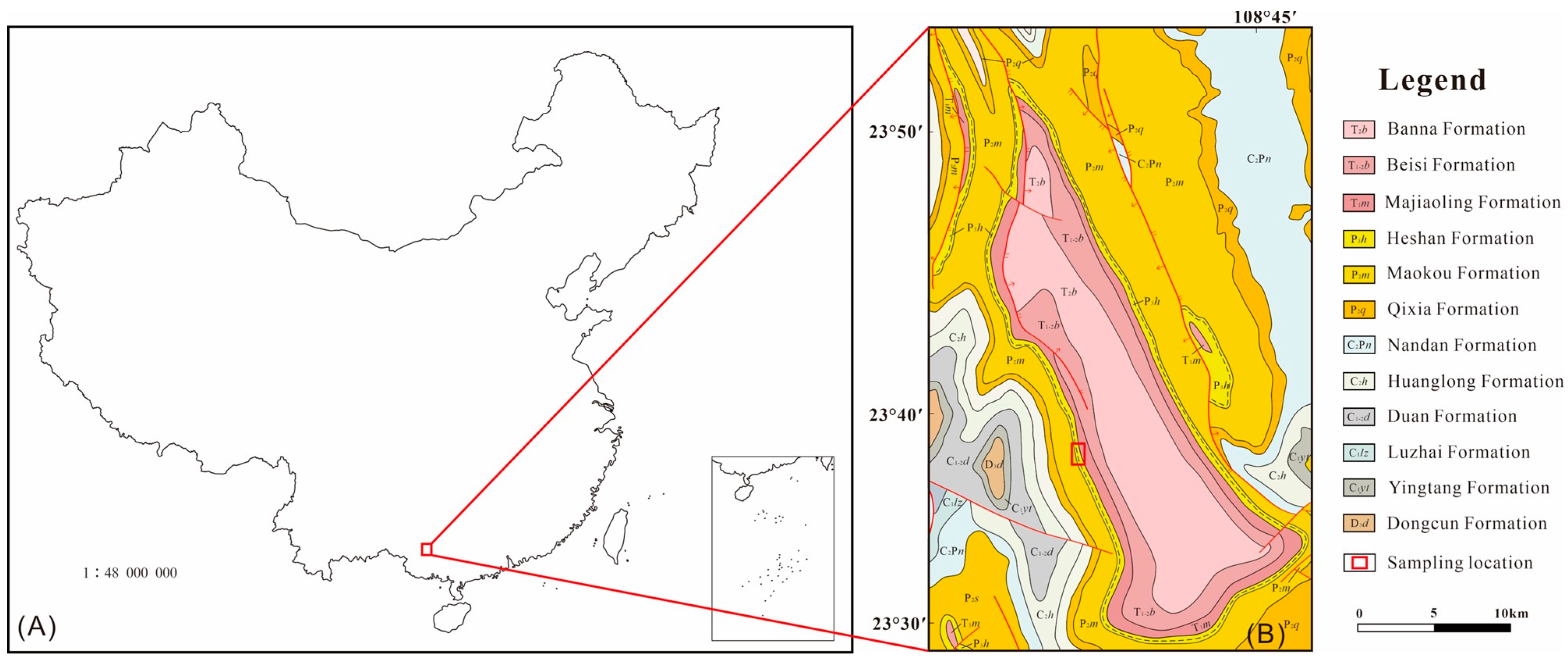
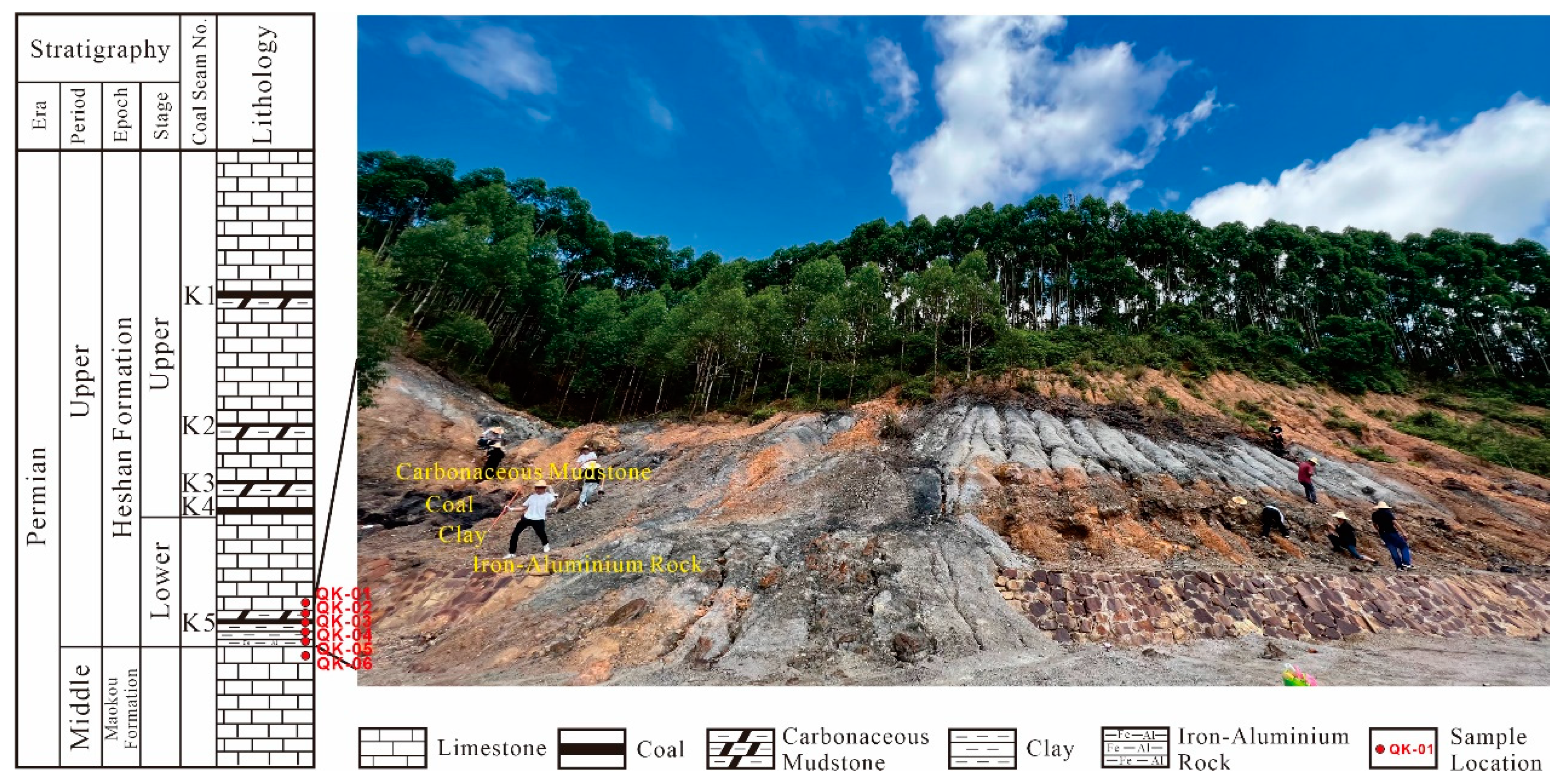

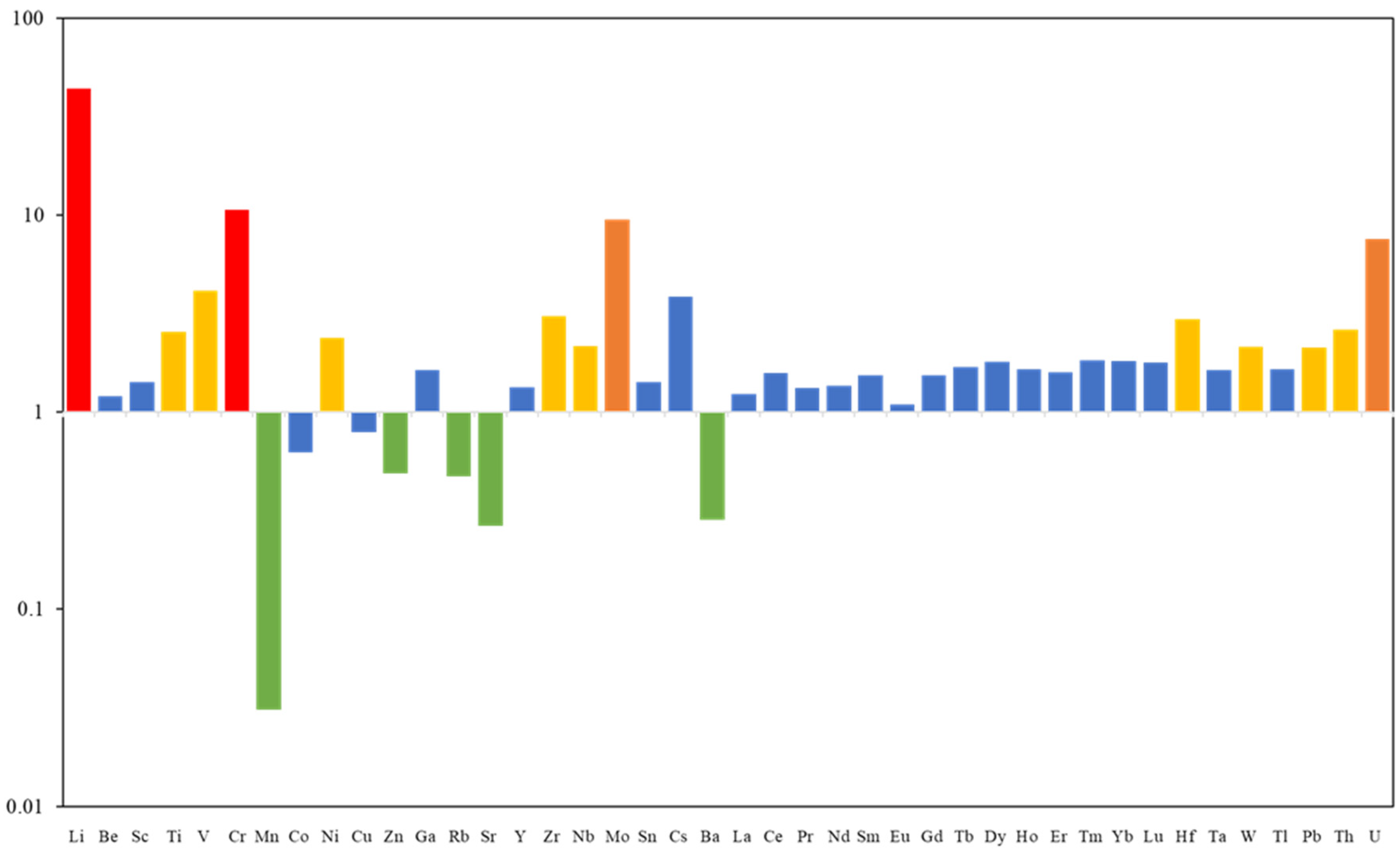
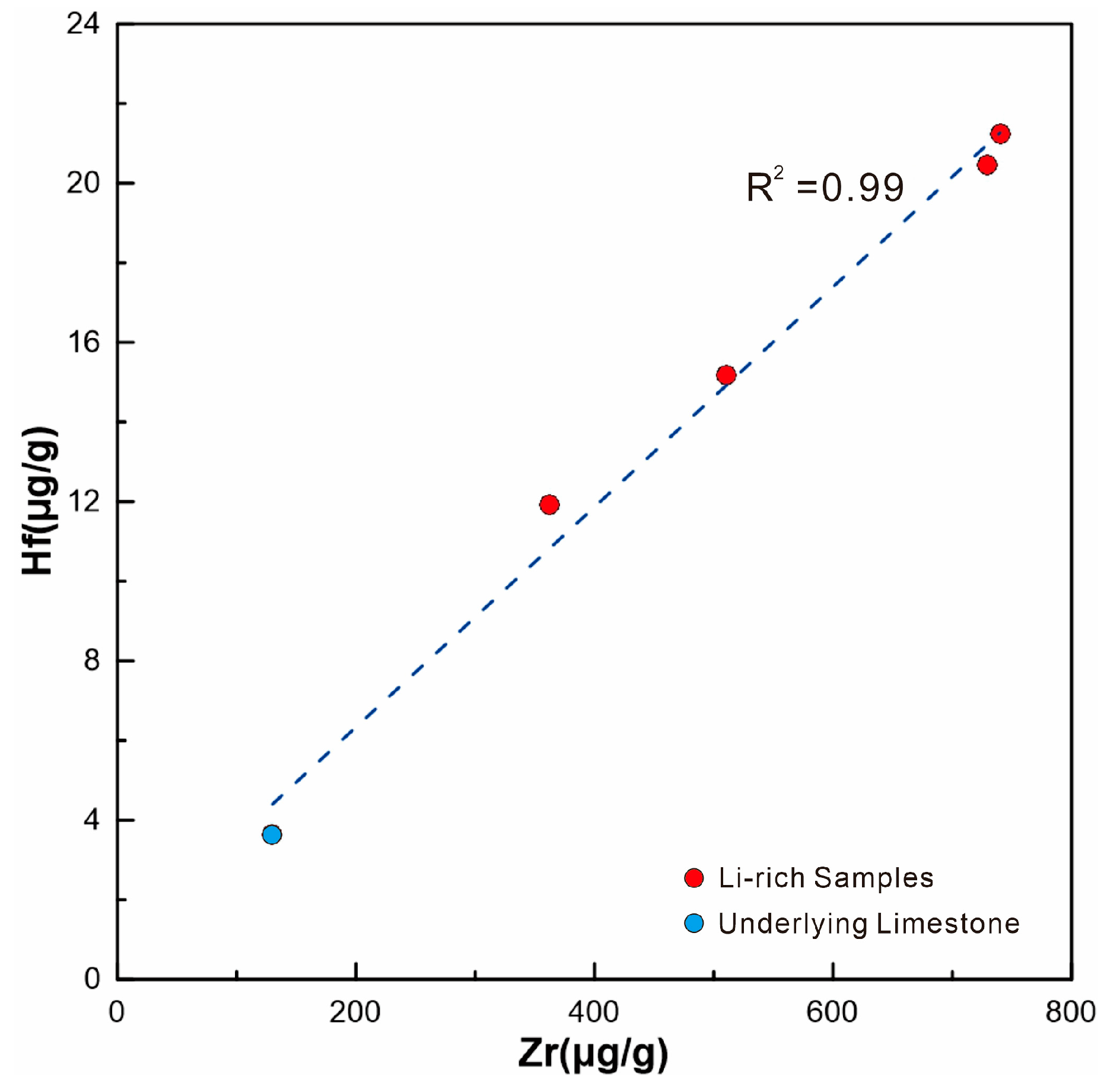
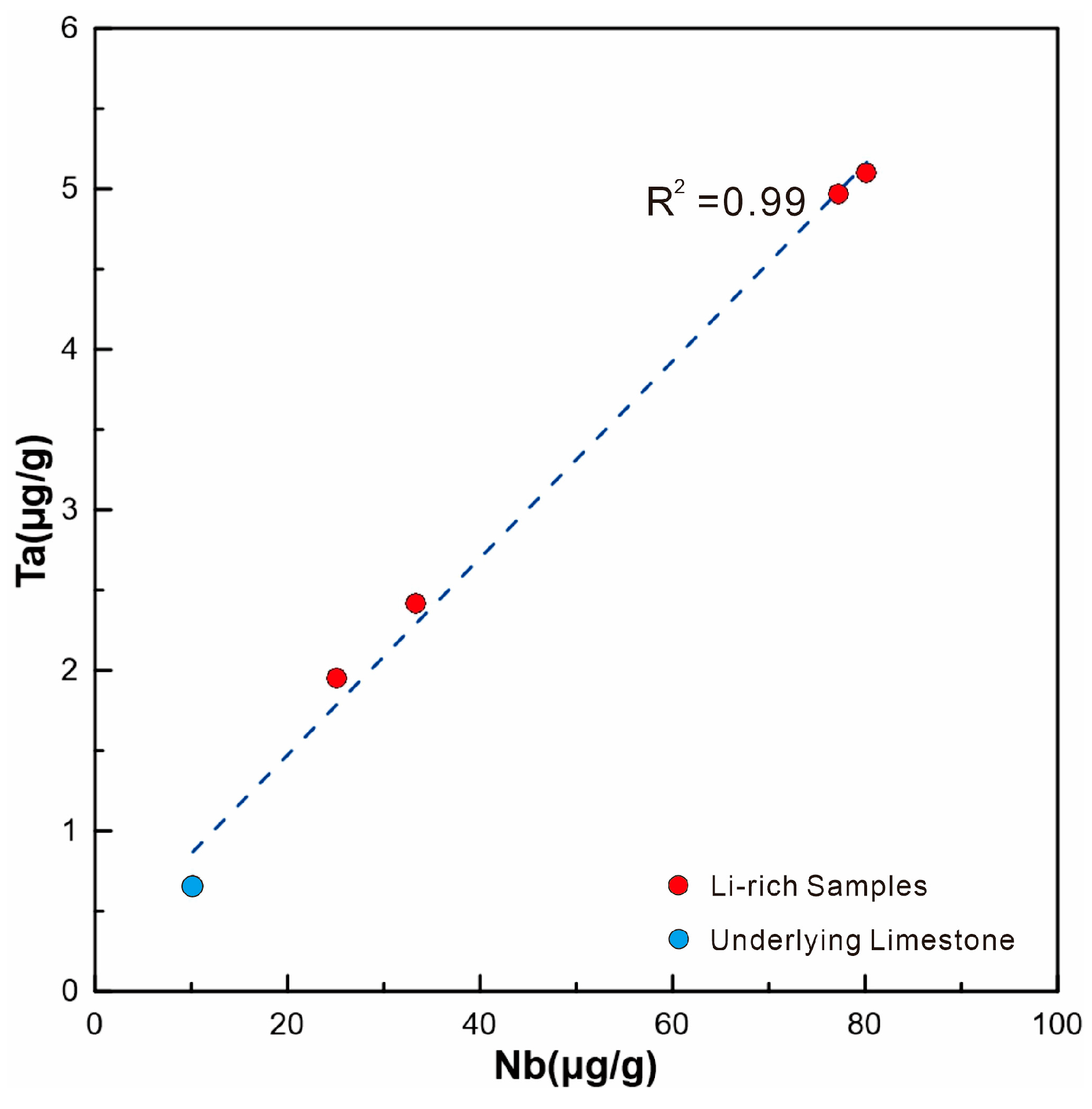
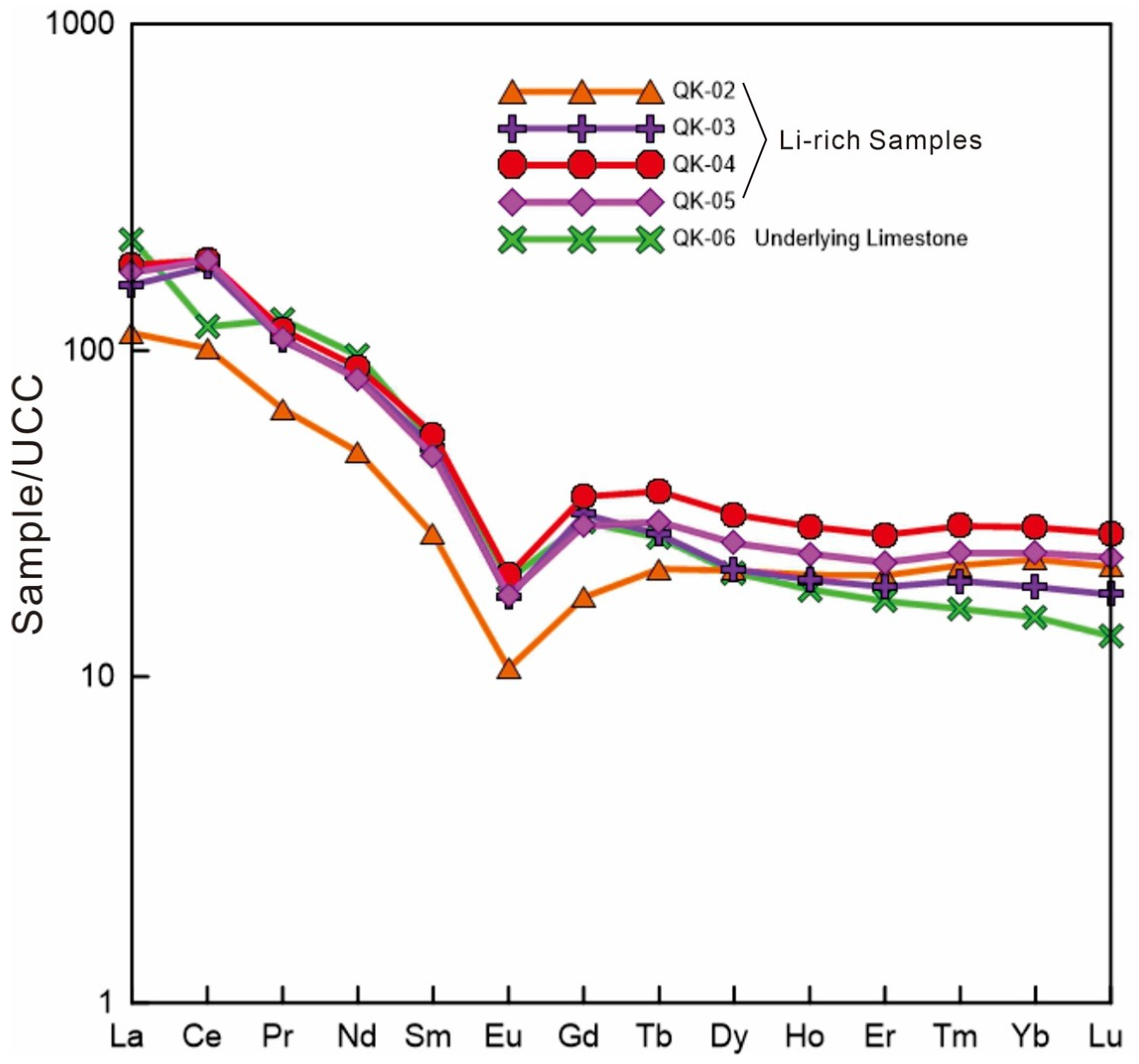
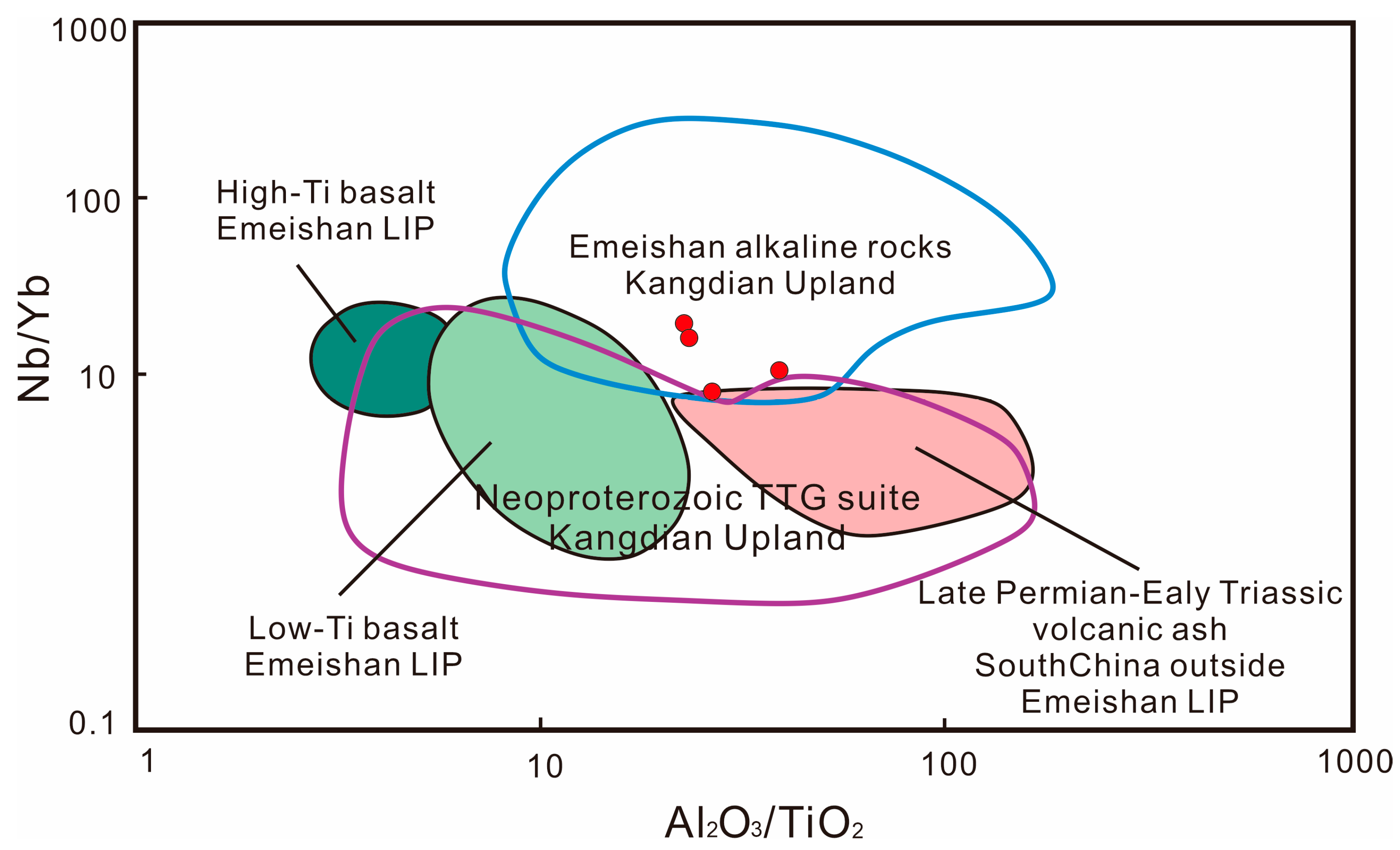

| Sample | Whole Rock Mineral Content | Relative Content of Clay Minerals | ||||||||
|---|---|---|---|---|---|---|---|---|---|---|
| Gypsum | Anatase | Quartz | Calcite | Pyrite | Clays | Illite | Kaolinite | Chlorite | Corrensite | |
| QK-06 | - | - | 3.3 | 96.7 | - | - | - | - | - | - |
| QK-02 | 0.5 | 0.9 | 10.6 | - | 5.8 | 81.3 | 42 | 0 | - | - |
| QK-03 | 0.6 | 0.4 | 0.5 | - | 2.3 | 96.3 | 2.9 | 63.4 | 10.8 | 8.6 |
| QK-04 | 1.7 | 0.9 | 0.8 | - | 1.1 | 95.5 | 18.9 | 41.5 | 9.3 | 8.1 |
| QK-05 | 1.5 | 1.7 | 4.8 | - | 0.6 | 91.5 | 15.5 | 44.9 | 10.0 | 5.8 |
| QK-01 | - | 0.1 | 10.8 | 80.0 | - | 9.0 | 39 | 5 | - | - |
| Sample | SiO2 | Al2O3 | MgO | Na2O | K2O | P2O5 | TiO2 | CaO | TFe2O3 | MnO | LOI | CIA |
|---|---|---|---|---|---|---|---|---|---|---|---|---|
| QK-06 | 3.43 | 0.23 | 0.76 | 0.08 | 0.05 | 0.01 | 0.02 | 53.13 | 0.12 | 0.01 | 41.42 | 52.74 |
| QK-02 | 46.55 | 28.68 | 0.74 | 1.44 | 4.02 | 0.02 | 1.13 | 0.35 | 5.08 | 0.00 | 12.36 | 83.14 |
| QK-03 | 40.55 | 39.44 | 0.27 | 0.29 | 0.51 | 0.02 | 1.04 | 0.40 | 1.90 | 0.01 | 16.14 | 97.31 |
| QK-04 | 44.39 | 37.33 | 0.41 | 0.80 | 1.41 | 0.02 | 1.66 | 0.32 | 1.01 | 0.01 | 12.69 | 93.63 |
| QK-05 | 45.27 | 36.79 | 0.42 | 1.00 | 1.52 | 0.02 | 1.65 | 0.34 | 0.91 | 0.00 | 12.12 | 92.79 |
| QK-01 | 18.41 | 4.86 | 0.58 | 0.39 | 0.40 | 0.02 | 0.18 | 40.82 | 1.14 | 0.02 | 32.77 | 80.34 |
| Sample | Li | Be | Sc | Ti | V | Cr | Mn | Co | Ni | Cu | Zn | Ga | Rb | Sr | Y | Zr | Nb | Mo | Sn | Cs | Ba |
|---|---|---|---|---|---|---|---|---|---|---|---|---|---|---|---|---|---|---|---|---|---|
| QK-06 | 0.94 | 0.48 | 1.35 | 71.58 | 11.55 | 64.64 | 63.39 | 0.64 | 9.42 | 8.39 | 4.07 | 0.68 | 1.35 | 989.99 | 23.48 | 6.80 | 0.46 | 0.43 | 0.17 | 0.10 | 12.70 |
| QK-02 | 185.38 | 3.15 | 18.31 | 6281.66 | 118.34 | 36.29 | 32.70 | 7.82 | 10.44 | 8.05 | 13.44 | 27.76 | 115.10 | 236.64 | 24.71 | 510.91 | 25.07 | 3.78 | 8.97 | 17.39 | 353.92 |
| QK-03 | 1319.83 | 3.52 | 8.38 | 5579.95 | 92.30 | 83.94 | 19.83 | 6.94 | 33.94 | 23.63 | 24.14 | 23.77 | 12.91 | 21.18 | 24.94 | 362.71 | 33.31 | 6.95 | 7.38 | 8.78 | 30.96 |
| QK-04 | 1001.22 | 3.89 | 21.49 | 9418.01 | 418.82 | 798.68 | 11.36 | 5.33 | 76.38 | 24.09 | 67.61 | 32.84 | 40.76 | 55.35 | 37.71 | 729.59 | 80.19 | 23.40 | 7.90 | 15.64 | 121.48 |
| QK-05 | 1009.04 | 3.94 | 14.55 | 9284.82 | 366.16 | 569.72 | 10.36 | 4.93 | 69.10 | 23.36 | 33.89 | 26.73 | 42.86 | 59.06 | 30.37 | 740.07 | 77.25 | 22.64 | 6.95 | 15.51 | 117.11 |
| QK-01 | 11.13 | 0.81 | 8.40 | 1153.63 | 58.31 | 104.53 | 161.07 | 0.55 | 8.09 | 6.15 | 12.83 | 5.35 | 10.34 | 1535.35 | 32.91 | 130.06 | 10.16 | 1.43 | 1.53 | 2.55 | 43.55 |
| Sample | La | Ce | Pr | Nd | Sm | Eu | Gd | Tb | Dy | Ho | Er | Tm | Yb | Lu | Hf | Ta | W | Tl | Pb | Th | U |
| QK-06 | 9.37 | 13.27 | 2.06 | 9.47 | 1.87 | 0.47 | 2.44 | 0.40 | 2.20 | 0.50 | 1.43 | 0.19 | 1.13 | 0.17 | 0.17 | 0.06 | 0.12 | 0.02 | 1.12 | 0.59 | 5.34 |
| QK-02 | 26.80 | 62.24 | 6.27 | 22.88 | 4.17 | 0.61 | 3.60 | 0.80 | 5.38 | 1.16 | 3.38 | 0.56 | 3.89 | 0.55 | 15.19 | 1.95 | 5.41 | 1.58 | 43.44 | 35.21 | 11.52 |
| QK-03 | 37.56 | 110.11 | 10.17 | 39.12 | 7.69 | 1.02 | 6.47 | 1.02 | 5.41 | 1.12 | 3.12 | 0.50 | 3.20 | 0.45 | 11.92 | 2.41 | 3.48 | 1.33 | 42.81 | 20.64 | 16.76 |
| QK-04 | 43.40 | 115.50 | 11.01 | 41.55 | 8.46 | 1.19 | 7.33 | 1.38 | 7.97 | 1.63 | 4.50 | 0.74 | 4.87 | 0.70 | 20.45 | 5.10 | 4.15 | 0.98 | 42.08 | 30.06 | 28.16 |
| QK-05 | 40.99 | 115.60 | 10.34 | 38.15 | 7.29 | 1.03 | 5.96 | 1.11 | 6.51 | 1.35 | 3.71 | 0.61 | 4.07 | 0.59 | 21.22 | 4.97 | 4.18 | 1.05 | 41.88 | 26.65 | 28.13 |
| QK-01 | 51.98 | 72.40 | 11.80 | 45.15 | 7.95 | 1.15 | 6.12 | 1.00 | 5.30 | 1.05 | 2.83 | 0.41 | 2.59 | 0.34 | 3.65 | 0.66 | 0.36 | 0.07 | 5.01 | 8.17 | 6.90 |
Disclaimer/Publisher’s Note: The statements, opinions and data contained in all publications are solely those of the individual author(s) and contributor(s) and not of MDPI and/or the editor(s). MDPI and/or the editor(s) disclaim responsibility for any injury to people or property resulting from any ideas, methods, instructions or products referred to in the content. |
© 2025 by the authors. Licensee MDPI, Basel, Switzerland. This article is an open access article distributed under the terms and conditions of the Creative Commons Attribution (CC BY) license (https://creativecommons.org/licenses/by/4.0/).
Share and Cite
Zhang, L.; Zhang, D.; Zhang, F.; Lin, Z.; Sun, J.; Yan, X.; Xu, H.; Di, S.; Huang, S.; Xu, X.; et al. Discussion on the Geochemical Characteristics and Enrichment Process of Li-Rich Layers in Xian’an Coalfield, Guangxi Province, China. Minerals 2025, 15, 404. https://doi.org/10.3390/min15040404
Zhang L, Zhang D, Zhang F, Lin Z, Sun J, Yan X, Xu H, Di S, Huang S, Xu X, et al. Discussion on the Geochemical Characteristics and Enrichment Process of Li-Rich Layers in Xian’an Coalfield, Guangxi Province, China. Minerals. 2025; 15(4):404. https://doi.org/10.3390/min15040404
Chicago/Turabian StyleZhang, Li, Degao Zhang, Fuqiang Zhang, Zhongyue Lin, Jie Sun, Xiaoyun Yan, Huiheng Xu, Shaobo Di, Shaoqing Huang, Xiaotao Xu, and et al. 2025. "Discussion on the Geochemical Characteristics and Enrichment Process of Li-Rich Layers in Xian’an Coalfield, Guangxi Province, China" Minerals 15, no. 4: 404. https://doi.org/10.3390/min15040404
APA StyleZhang, L., Zhang, D., Zhang, F., Lin, Z., Sun, J., Yan, X., Xu, H., Di, S., Huang, S., Xu, X., & Zou, Z. (2025). Discussion on the Geochemical Characteristics and Enrichment Process of Li-Rich Layers in Xian’an Coalfield, Guangxi Province, China. Minerals, 15(4), 404. https://doi.org/10.3390/min15040404







